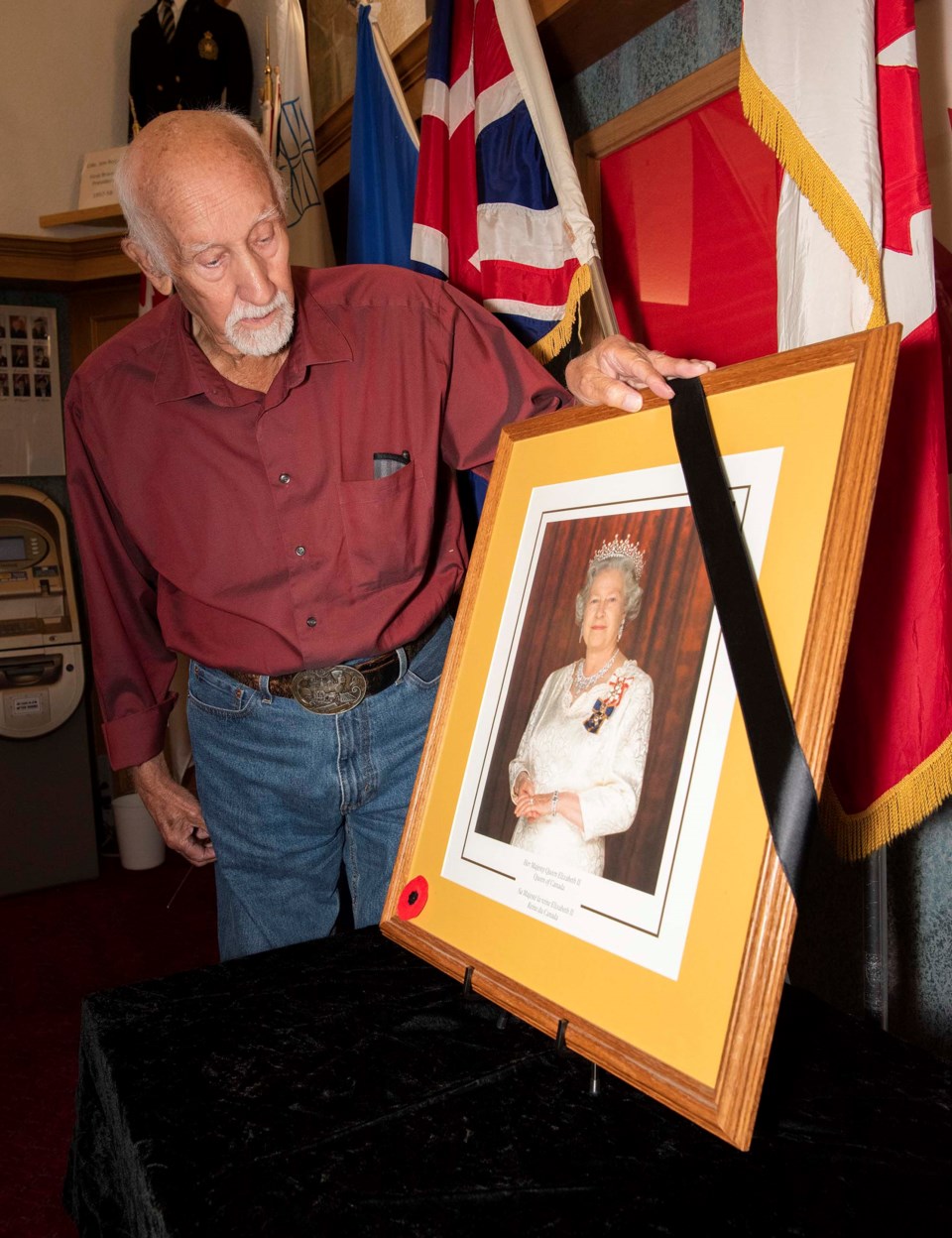When the news broke Thursday that Queen Elizabeth II had died, St. Albert veteran Malcolm Simmons said he was saddened, but not surprised. He remembered her as a young woman during the Second World War and saw her in parades and at other public events.
But while many Canadians knew the Queen only as a face on a coin, Simmons got to work up close with the monarch for several years at Buckingham Palace.
“She was my queen, and I was her security,” he recalled, in an interview at the St. Albert Legion Hall Sept. 8.
Flags flew at half-mast across St. Albert and Canada Thursday, Sept. 8 following the death of Queen Elizabeth II at age 96.
Elizabeth II was the longest-reigning monarch in Commonwealth history, having ascended to the throne on Feb. 6, 1952, at age 25.
Elizabeth II had the second-longest reign of any European monarch, noted St. Albert historian Ray Pinco.
“The only monarch who technically had a longer reign is Louis XIV of France,” he said, at 72 years, but Louis didn’t do much as king at first since he started when he was five.
“That’s really remarkable.”
Now what?
Elizabeth II was Canada’s head of state, representing the Crown, which forms the basis of Canada’s parliamentary democracy, writes Nathan Tidridge, vice-president of the Institute for the Study of the Crown in Canada.
“For most Canadians, Elizabeth II has been the only monarch they have ever known,” Tidridge writes.
Succession is automatic and instantaneous under Canadian law, so the Queen’s death has no direct effect on Canadian governance, Tidridge writes — the Crown as an institution continues, as per the phrase, “The Queen is dead, long live the King.” Prince Charles became King Charles III upon the Queen’s death and took over her role in Canada’s government.
Stamps, currency, medals, landmarks, and other items named after Elizabeth II or featuring her image are all still valid, although future stamps and monies will likely feature King Charles, reported the Alberta government’s website on the Queen’s death. Passports issued in “the name of Her Majesty, the Queen” are valid until they expire; new ones will have updated wording. New citizens, elected officials, and public servants who swore oaths to the Queen will not have to swear new ones, as those oaths are to the Crown rather than a specific person.
The Court of Queen’s Bench is now the Court of King’s Bench as per provincial law, the province said — a change which should not affect any court cases. Some 4,500 references to the Court of Queen’s Bench or Her Majesty in about 350 provincial acts and regulations will also have to be updated. All official photos or paintings of Elizabeth II in public buildings are now to be draped in black until they can be replaced with King Charles’s official photo.
Federal, provincial, and municipal leaders issued statements on the Queen’s passing Thursday afternoon.
“The Queen lived a life committed to history and duty, but in addition, she was a wife, a mother, a grandmother, and a great grandmother,” Sturgeon County Mayor Alanna Hnatiw said in a media release.
“There are many who will feel this loss deeply.”
While many have different views on the Royal Family and its influence on Canadian history, Hnatiw said she hopes everyone can respect differences of opinion to allow everyone to reflect in their own way.
In a statement, Morinville Mayor Simon Boersma extended his deepest condolences to the Royal Family.
“For 70 years, she reigned with grace, dedicated her life to public service, and demonstrated exemplary leadership. I encourage each of us to take a moment to honour Her Majesty’s memory in our own individual way.”
Remembrances
Simmons grew up in Britain and was the sole armed police officer at Buckingham Palace for several years in the 1960s.
“I had a gun,” he said — unusual, as most police did not carry firearms in those days — and his job was to protect the Queen and her relatives while they were at the palace.
Simmons said most of his conversations with the Queen were formal in nature, adding that he spent more time with the Queen Mother than Elizabeth II. He also sometimes had to watch the royal dogs. No one tried anything criminal at the palace while he was there.
Pinco said he remembered how his teacher went to the front of the class at the old brick school on Mission Hill back in 1952 to tell everyone that King George VI died. St. Albert wasn’t much more than the downtown core and Mission at the time, and Braeside was just a few houses.
“It was difficult to remember to say, ‘God save the Queen’ rather than, ‘God save the King,’” Pinco said, which was a bigger deal back in the 1950s, when people would sing God Save the King/Queen at public events and toast the monarch at every banquet.
While Pinco managed to see the Queen several times during her 22 visits to Canada, Simmons said he never encountered her again after he came to Canada in the 1970s.
Simmons said he will remember Elizabeth II as a woman of confidence who served well.
“She was certainly to me [what] I would expect a queen to be.”
Residents can sign books of condolences at various public buildings, including the Morinville town office.




